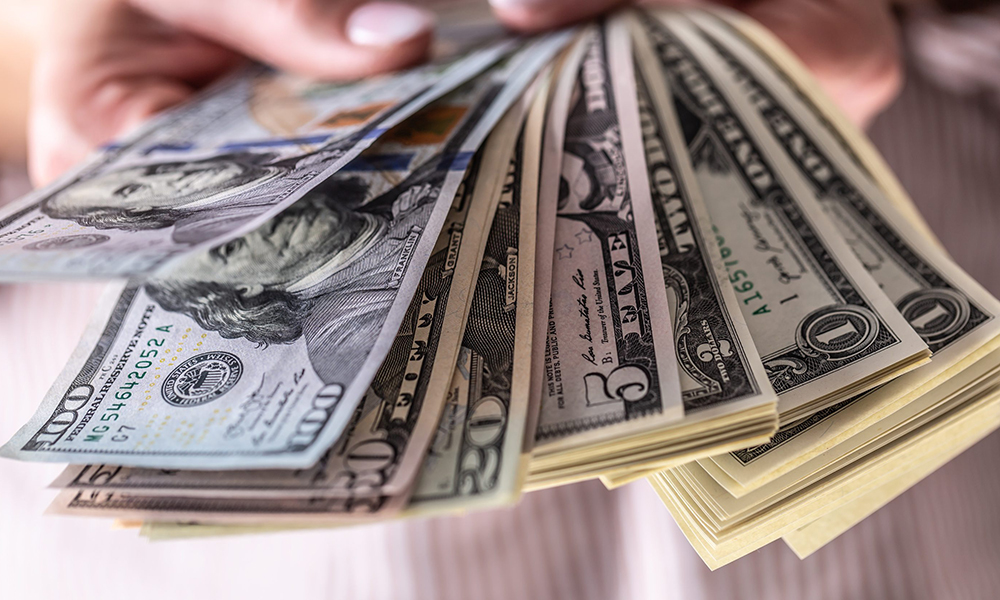美国人尚未耗尽疫情期间的储蓄

美国经济并非无路可走,因为摩根大通发现,美国人还没有完全耗尽他们在疫情期间积累的储蓄。
华尔街面临的最大问题之一是,美国家庭的兜里还有多少“弹药”来推动消费持续扩大。根据摩根大通发布的最新《家庭脉动》(Household Pulse)研究报告(该研究利用了约900万摩根大通客户的匿名数据),到2023年第一季度末,所有收入群体的银行存款余额中位数仍比2019年底高出10%至15%。
不过,这是自次年 4 月疫情首次在全球蔓延以来观察到的最薄弱的“缓冲”。
摩根大通研究所(JPMorgan Chase Institute)所长、该研究的主要作者克里斯·惠特(Chris Wheat)还在这一系列研究中首次纳入了基于种族和民族的分析。
数据显示,与白人和亚裔家庭相比,非裔和拉美裔家庭一直较为贫困,他们的储蓄消耗得更快。
作者写道:“到2023年3月底,这两个群体的银行存款余额都低于3000美元,接近疫情前的水平。”
贷款条件收紧,违约率上升
总体数据可能有助于解释,为什么在2023年即将到来的经济衰退首次成为共识之后,美国强劲的经济数据却屡屡打经济学家们的脸。
不过,德意志银行(Deutsche Bank)仍然相信,美国消费者耗尽刺激经济的燃料(疫情期间的储蓄)只是时间问题。
该机构最近预测,从第四季度开始,美国经济活动将继续萎缩。
尽管劳动力市场持续强劲且通胀降温,但仍有一些令人担忧的迹象表明,随着贷款环境恶化,最易受打击的消费者正竭力确保收支平衡。
根据美联储的一项新调查,美国人申请某种形式的信贷——无论是抵押贷款、新车贷款还是信用卡——的总体拒绝率上升到21.8%,是2018年6月以来的最高水平。
上周Apollo Global Management首席经济学家托斯滕·斯洛克(Torsten Slok)警告称,随着美联储紧缩周期的影响慢慢波及规模达26万亿美元的美国经济,从汽车贷款、信用卡到高收益公司债务等各类贷款的违约率都在上升。
斯洛克上周对彭博电视台(Bloomberg TV)表示:“从大局出发,对消费者和企业来说,违约周期已经开始。因此,这是令人痛苦的,只是还没有在宏观层面显现出来。”(财富中文网)
译者:中慧言-王芳
美国经济并非无路可走,因为摩根大通发现,美国人还没有完全耗尽他们在疫情期间积累的储蓄。
华尔街面临的最大问题之一是,美国家庭的兜里还有多少“弹药”来推动消费持续扩大。根据摩根大通发布的最新《家庭脉动》(Household Pulse)研究报告(该研究利用了约900万摩根大通客户的匿名数据),到2023年第一季度末,所有收入群体的银行存款余额中位数仍比2019年底高出10%至15%。
不过,这是自次年 4 月疫情首次在全球蔓延以来观察到的最薄弱的“缓冲”。
摩根大通研究所(JPMorgan Chase Institute)所长、该研究的主要作者克里斯·惠特(Chris Wheat)还在这一系列研究中首次纳入了基于种族和民族的分析。
数据显示,与白人和亚裔家庭相比,非裔和拉美裔家庭一直较为贫困,他们的储蓄消耗得更快。
作者写道:“到2023年3月底,这两个群体的银行存款余额都低于3000美元,接近疫情前的水平。”
贷款条件收紧,违约率上升
总体数据可能有助于解释,为什么在2023年即将到来的经济衰退首次成为共识之后,美国强劲的经济数据却屡屡打经济学家们的脸。
不过,德意志银行(Deutsche Bank)仍然相信,美国消费者耗尽刺激经济的燃料(疫情期间的储蓄)只是时间问题。
该机构最近预测,从第四季度开始,美国经济活动将继续萎缩。
尽管劳动力市场持续强劲且通胀降温,但仍有一些令人担忧的迹象表明,随着贷款环境恶化,最易受打击的消费者正竭力确保收支平衡。
根据美联储的一项新调查,美国人申请某种形式的信贷——无论是抵押贷款、新车贷款还是信用卡——的总体拒绝率上升到21.8%,是2018年6月以来的最高水平。
上周Apollo Global Management首席经济学家托斯滕·斯洛克(Torsten Slok)警告称,随着美联储紧缩周期的影响慢慢波及规模达26万亿美元的美国经济,从汽车贷款、信用卡到高收益公司债务等各类贷款的违约率都在上升。
斯洛克上周对彭博电视台(Bloomberg TV)表示:“从大局出发,对消费者和企业来说,违约周期已经开始。因此,这是令人痛苦的,只是还没有在宏观层面显现出来。”(财富中文网)
译者:中慧言-王芳
The U.S. economy may still have road yet to run, as JPMorgan discovered Americans haven’t quite finished raiding their pandemic-era piggy banks.
One of the biggest questions facing Wall Street is how much powder households have been able to keep dry to fuel future purchases, and according to the latest Household Pulse study published by JPMorgan using anonymized data from roughly 9 million Chase customers, the median bank balance across all income groups still remained between 10% and 15% higher at the end of the first quarter of 2023 than at the end of 2019.
This cushion is, however, the thinnest observed since the pandemic first spread worldwide in April of the following year.
Chris Wheat, President of the JPMorgan Chase Institute and lead author of the study, also included an analysis based on race and ethnicity for the first time in the series of studies.
Data suggested that Black and Hispanic households—consistently poorer compared to their white and Asian peers—are burning through their reserves faster.
“By the end of March 2023, balances for both groups were below $3,000, approaching their respective pre-pandemic levels,” the author wrote.
Delinquency rates on the rise as lending conditions tighten
The overall data might help explain why economists have been consistently confounded by just how robust the economy remains long after an impending 2023 recession first became a consensus view.
Nevertheless, Deutsche Bank remains convinced it’s just a matter of time before U.S. consumers will run out of fuel to stoke the economic fires.
It recently predicted the country remains on track for activity to contract starting in the fourth quarter.
Despite the continued strong labor market and cooling inflation, there are some worrying signs that the most vulnerable consumers are struggling to ensure ends meet as lending conditions deteriorate.
According to a new Federal Reserve survey, the overall rejection rate for Americans applying for some form of credit—whether it’s a mortgage, new car loan, or a credit card—increased to 21.8%, the highest level since June 2018.
Last week Apollo Global Management chief economist Torsten Slok warned that delinquency rates were rising on everything from auto loans and credit cards to high-yield corporate debt as the effects of the Fed’s tightening cycle slowly ripple across the $26 trillion U.S. economy.
“Across the board, both for consumers and for corporates, the conclusion is a default cycle has started,” Slok told Bloomberg TV last week. “So it is biting, it’s just not showing up at the macro level quite yet.”













